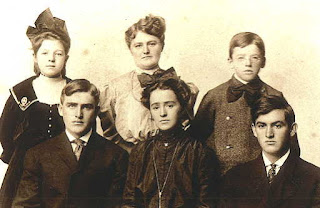The previous blog post pertained to the local Indiana National Guard Field Artillery unit that became the 150th Field Artillery when they were all shipped to France in October, 1917. After a thorough search through all the Crawfordsville Daily Journals from 1917-1918, almost one hundred letters from our soldiers were found, or news was shared by families. In researching each of the soldiers in the picture in the previous post, I found some shocking information. Frank Manning, of Darlington, was reported to his parents as being killed in action during the spring of 1918. This must have been terrible for that family. However, I found a letter written on November 11, 1918, describing the last day of the war, written by Frank Manning of Darlington. I was puzzled. With further research, I found that a different Frank Manning from New York had died that day, and not the Frank from Darlington.
An excerpt from Manning’s note, written on Nov. 11, 1918, and printed in the Crawfordsville Daily Journal on December 20, 1918, read:
“I am on the front, yet a front that 48 hours ago was the hottest and bloodiest front of the war and has been since August, 1914. In this ruined French village… there are perhaps 200 souls. They have been under German yoke for four years and they look more like hunted animals than human beings. … to have peace, blessed peace in so short a time, is more than their tortured souls can stand.”
Claude Grissom wrote home to his mother on September 10, and the letter appeared on October 28, 1918.
"Well, Mother, Old Fritzy just sent over his best regards just now, about a 210 shell, I think. I met an old buddy of mine from Crawfordsville. His name is Jack Harris. I saw L. Merrell about a month ago. Have not seen Clarence Zook for four or five months."
Albert Wright served alongside his brother, Cecil. Albert wrote to his sister on September 21, 191, and it was printed on November 4, 1918.
"One big boche prisoner was coming down the road with about 100 others smoking a pipe that looked like a young steam engine; he was all smiles. Well, in less time that it takes to tell it, I rode up to him and grabbed it out of his mouth."
"Another column of prisoners came at dawn: I cited a big Prussian officer. With very few words, I told him I wanted his cap, which he gave up very gratefully. I a few minutes I discovered his cap was full of--not bombs--but genuine Turkish cigars!"
An excerpt from Manning’s note, written on Nov. 11, 1918, and printed in the Crawfordsville Daily Journal on December 20, 1918, read:
“I am on the front, yet a front that 48 hours ago was the hottest and bloodiest front of the war and has been since August, 1914. In this ruined French village… there are perhaps 200 souls. They have been under German yoke for four years and they look more like hunted animals than human beings. … to have peace, blessed peace in so short a time, is more than their tortured souls can stand.”
 |
| www.findagrave.com |
"Well, Mother, Old Fritzy just sent over his best regards just now, about a 210 shell, I think. I met an old buddy of mine from Crawfordsville. His name is Jack Harris. I saw L. Merrell about a month ago. Have not seen Clarence Zook for four or five months."
Albert Wright served alongside his brother, Cecil. Albert wrote to his sister on September 21, 191, and it was printed on November 4, 1918.
"One big boche prisoner was coming down the road with about 100 others smoking a pipe that looked like a young steam engine; he was all smiles. Well, in less time that it takes to tell it, I rode up to him and grabbed it out of his mouth."
"Another column of prisoners came at dawn: I cited a big Prussian officer. With very few words, I told him I wanted his cap, which he gave up very gratefully. I a few minutes I discovered his cap was full of--not bombs--but genuine Turkish cigars!"




